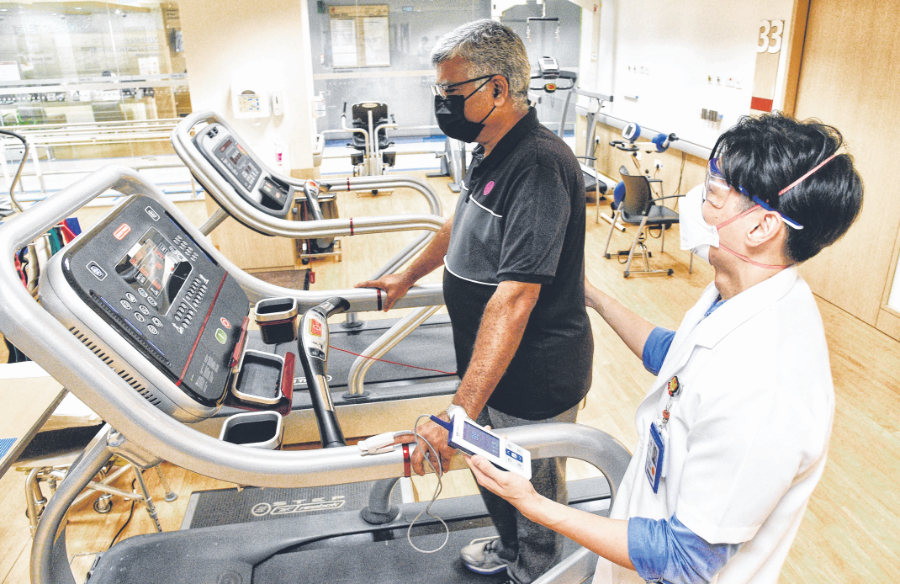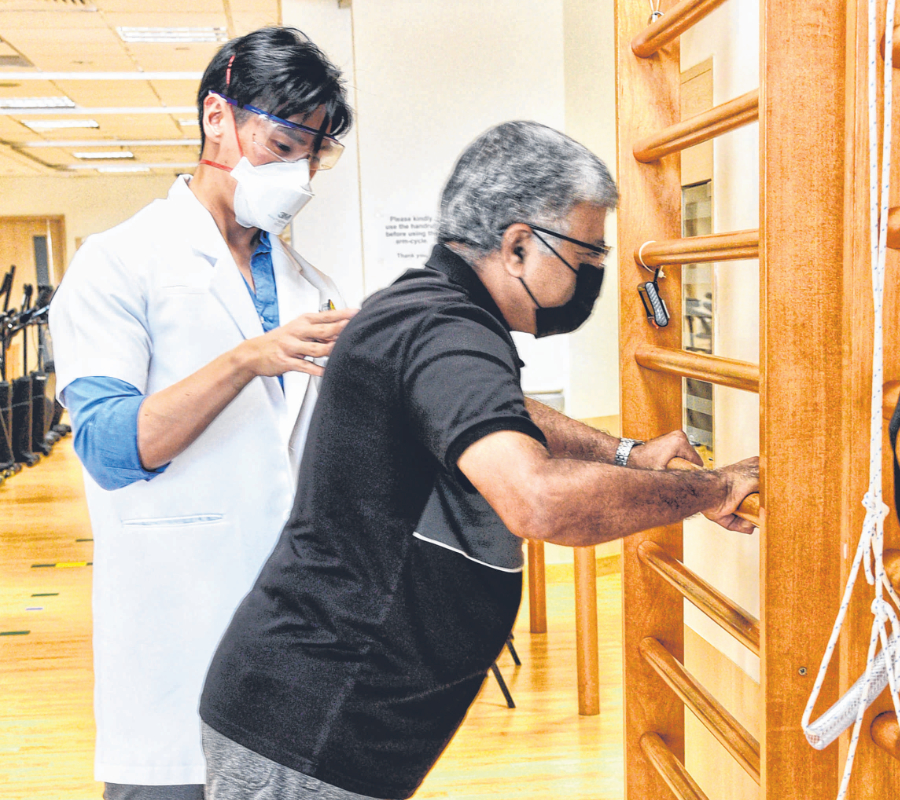 Physiotherapist Javier Luo assisting Mr Sathish Kumar, 52, with some of the prescribed exercises to strengthen the muscles in his arms and legs at Tan Tock Seng Hospital on Tuesday. Mr Sathish goes there for structured physiotherapy sessions once every three weeks. ST PHOTOS: DESMOND WEE
Physiotherapist Javier Luo assisting Mr Sathish Kumar, 52, with some of the prescribed exercises to strengthen the muscles in his arms and legs at Tan Tock Seng Hospital on Tuesday. Mr Sathish goes there for structured physiotherapy sessions once every three weeks. ST PHOTOS: DESMOND WEE
The Sunday Times (26 September 2021)
About four months ago, Mr Sathish Kumar was in the intensive care unit (ICU) at the National Centre for Infectious Diseases, intubated and fighting for his life, having contracted Covid-19.
The 52-year-old engineer survived the ordeal and was moved from the ICU after about two weeks.
But he was so weak that he could not get out of bed to go to the toilet or brush his teeth without help. He was nursed back to health, thanks to the medical team at Tan Tock Seng Hospital (TTSH).
The physiotherapists first saw him on May 25 – the day he was discharged from the ICU – and taught him some simple exercises. Mr Sathish said in an interview on Thursday that these were critical in helping him regain the strength he lost after being confined to a hospital bed for weeks.
Many Covid-19 survivors require physiotherapy as part of their recovery. The TTSH physiotherapy team has seen more than 400 recovered Covid-19 patients since the start of the pandemic last year.
Healthy patients with mild forms of Covid-19 might need just a few sessions, while more severely ill patients might need a few months of rehabilitation. Exercises are tailored to what each individual needs.
Following Mr Sathish’s discharge from the ICU, he had to work on lifting his arms and legs, activating the muscles that allowed him to move around. His physiotherapists saw him once a day.
As his oxygen levels were low at first, they had to be closely monitored, along with his heart rate. Sometimes he needed oxygen, which can be low among recovering patients, during exercise.
As his health slowly improved, he was taught how to stand and do slow marching exercises on the spot. Breathing exercises, such as how to relax and breathe deeply, were also critical.
Mr Sathish was diagnosed with Covid-19 early in May when he returned from a visit to India to see his mother. His condition deteriorated and he was moved to the ICU on May 12. He was discharged from hospital on June 9.
Since then, Mr Sathish has been diligent about doing his exercises and has seen his health improve to close to his pre-Covid-19 state. He does his exercises twice a day – in the morning and after work.
The exercises are simple, such as push-ups against the wall, lifting light weights and marching on the spot. Mr Sathish has diabetes as a pre-existing condition.
Dr Puah Ser Hon, a consultant in respiratory and critical care medicine at TTSH who was on Mr Sathish’s care team, said that Mr Sathish’s recovery is considered good, given that he had developed a serious form of Covid-19 and needed invasive mechanical ventilation.
“Most patients have a recovery like Mr Sathish’s. But if patients take a turn for the worse while in ICU, such as if they develop multiorgan failure or require more lung support, then they may stay longer in the ICU or die,” Dr Puah said.
Currently, Mr Sathish returns to TTSH as an outpatient for structured physiotherapy sessions once every three weeks.
He has gone back to work and is able to travel around independently, but some residual symptoms continue to linger.
He still tires more easily and occasionally experiences breathing difficulties.
The father of two children said: “Even though this is a serious infection and I had to go through a hard time, I am really thankful to everyone in the medical team, including the physiotherapists, doctors and nurses, for their support. If not for them, I wouldn’t have been able to come out of this ordeal and have a new lease of life.”
Ms Audrey Lee, a senior physiotherapist at TTSH, said: “Starting rehabilitation early, even when a patient is still in the ICU, is beneficial and helps patients recover faster.”
This debunks the conventional wisdom that rest is the best way to recover quickly.
 Physiotherapist Javier Luo assisting Mr Sathish Kumar, 52, with some of the prescribed exercises to strengthen the muscles in his arms and legs at Tan Tock Seng Hospital on Tuesday. Mr Sathish goes there for structured physiotherapy sessions once every three weeks. ST PHOTOS: DESMOND WEE
Physiotherapist Javier Luo assisting Mr Sathish Kumar, 52, with some of the prescribed exercises to strengthen the muscles in his arms and legs at Tan Tock Seng Hospital on Tuesday. Mr Sathish goes there for structured physiotherapy sessions once every three weeks. ST PHOTOS: DESMOND WEE
“Over the years, research has shown us that early rehabilitation by physiotherapists actually helps the patient feel better and go home faster,” Ms Lee said.
With more Singaporeans being infected with the virus and in conjunction with World Physiotherapy Day on Sept 8, the TTSH physiotherapy department has produced two exercise booklets containing strengthening, endurance and balance exercises, for patients who have recovered from Covid-19 to reduce any lingering symptoms, and for the general public.
“With more Singaporeans getting infected with Covid-19, a majority of them might be otherwise healthy, have no medical issues and do not need hospital care. This group of people can practise these exercises at home now that the booklets are available on the TTSH website,” Ms Lee said.
She added that patients with medical conditions should always consult their doctors to determine what kind of exercises are suitable for them.
“Many have the misconception that they can exercise only outdoors, but in fact, exercises can be done within their own home and staying home does not necessarily mean they have to be inactive.”
Starting rehabilitation early, even when a patient is still in the ICU, is beneficial and helps patients recover faster. Over the years, research has shown us that early rehabilitation by physiotherapists actually helps the patient feel better and go home faster."
- MS AUDREY LEE , a senior physiotherapist at Tan Tock Seng Hospital, on research debunking the conventional wisdom that rest is the best way to recover quickly.
The exercise booklets can be downloaded here: